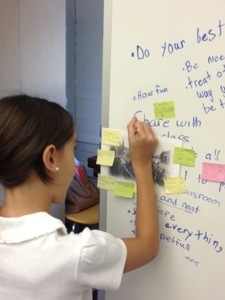It is a belief held by the PYP that students should be invited to investigate important subject matter by formulating their own questions. This idea of forming questions is one of the main steps in the inquiry cycle and, for me, the crucial starting point.
When I carry out workshops about inquiry I always show the ‘simple’ inquiry model generated through the work of John Dewey. I like it because staff can add their own thoughts and feelings about what each stage means to them, their teaching and the students they work with. I always state how the ‘ask’ part of the cycle is essential to generate further work and learning. This is the chance for teachers to stimulate engagement with the central idea/driving concept of a unit. Through using carefully selected provocations a teacher should look to create tension, provoke puzzlement and allow the student to wander and wonder. These will hook the students and then they become fully immersed and invested in their learning – motivated to find out answers to questions. Indeed Bruner said that if a student has interest in material that this is the best stimulus to learning.
I am a big advocate of using visible thinking routines, developed by research at Harvard , as a way in to a unit. Accompanying images, videos or artifacts activities such as ‘see-think-wonder’ (what do you see, what are you thinking, what would you like to explore further) and ‘think-puzzle-explore’ (what do you think, what puzzles you, what would you like to explore further) are a great way to challenge the student. These generate a high degree of curiosity in the students and give rise to learning. Through these early engagements teachers get an idea of the level of understanding students have about a unit of inquiry and can start to structure some meaningful learning engagements. I once started a unit focusing on ‘simple machines’ (How the World Works) by watching both Tom and Jerry cartoons and Wallace and Gromit. First of all the students loved it, but secondly, and more importantly they came up with some really fascinating questions based around our driving questions – how do machines work? why do we have machines?

Students carrying out a ‘see-think-wonder’ while investigating images for our unit of past civilizations.
 These early entry points into the unit would be built into our planned learning engagements to move the students from their current level of understanding to a new and deeper level.
These early entry points into the unit would be built into our planned learning engagements to move the students from their current level of understanding to a new and deeper level.
Having just carried out our self study (a process of evaluation for all PYP schools) I find myself often referring to standard A (3C) of the PYP Standards and Practices document which states, “The school is committed to a constructivist, inquiry-based approach to teaching and learning that promotes inquiry and the development of critical-thinking skills.” This is an area of growth for us and we are making great strides. I emphasize that this means that even lessons that fall outside the unit of inquiry and are deemed ‘stand alone’ should still be using an inquiry based method.
I really relish having professional dialogue with colleagues about inquiry. We think about what it looks like in a classroom, how we can assess it and how it works – through these conversations we (and our students) learn. Peer observations is a great tool for teachers to model and experience inquiry. It becomes even more successful when time is giving to reflect and discuss what was seen.
Currently, in school we are planning collaboratively in grade level teams to think of some crucial starting points that will provoke, challenge and engage the young inquiring minds in our classes. It is amazing to here some of the ideas and activities that are planned and I am excited to see the resulting questions and wonderings.
